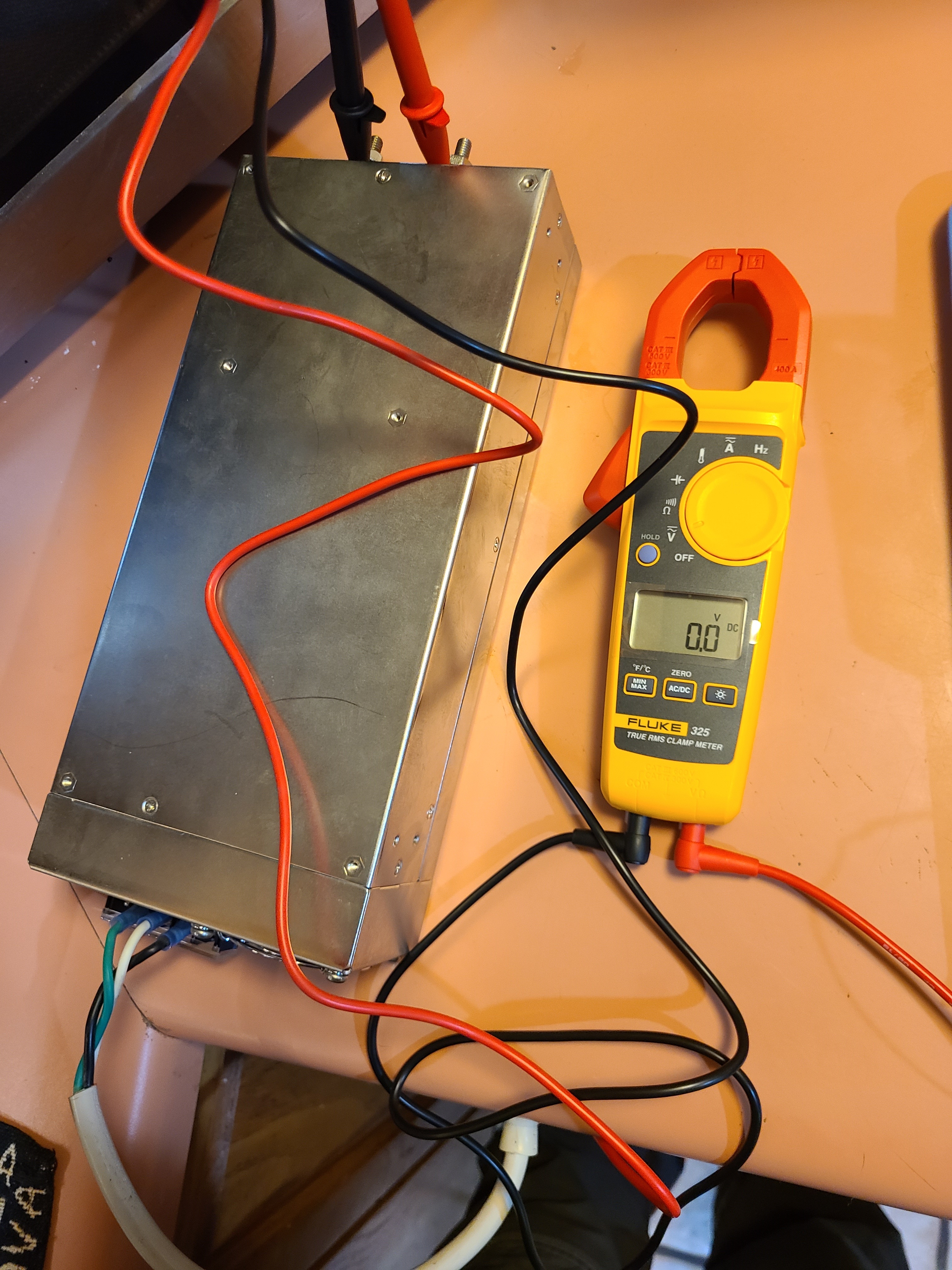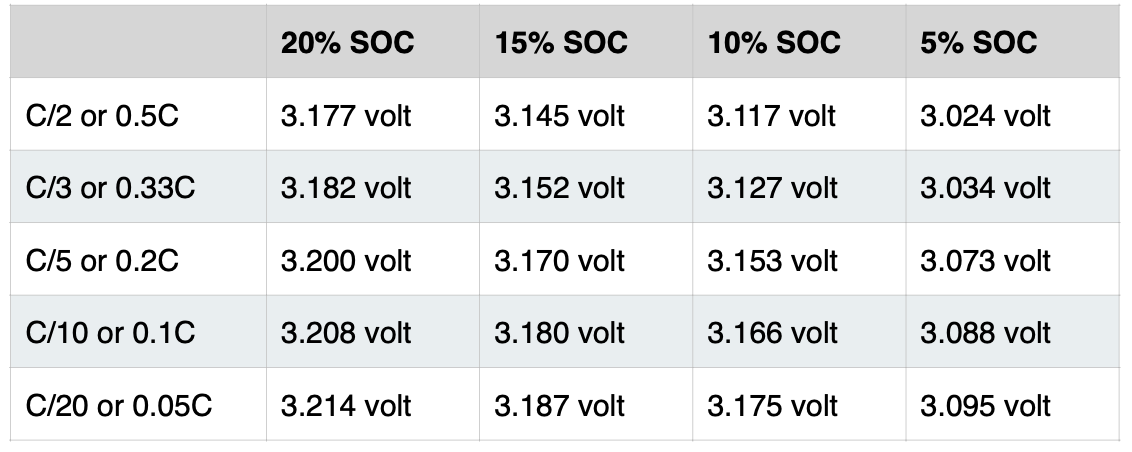Hi Everyone,
First post here. I know many of you are miles ahead of me, so I'm posting this humbly and hoping for some (kind) input. I have an old EET degree that I never really put to use, and I've forgotten more than I've learned. But I'm catching up quick lately on account of wanting to put a ~20kW LFP bank in my new 2020 awd high roof transit w/2" lift, bigger tires, etc. I plan to have a 250A 24V alternator.
I've got the plant director of a small lithium battery manufacturer in China sending me two 3.2V 100AH prismatic LiFePO4 cells so that I can stress test them. I'm mostly interested in how the cells perform at higher temperatures (40C-70C), with relatively low charge (0.33C) and discharge rates (0.5C, 03C, 0.2C, and 0.1C).
When the time comes and I order the larger battery bank, I'll have a 6kW sigineer inverter/charger, and the 250A 24V alternator + wakespeed regulator, but at the moment, I don't have the means to charge/discharge single cells, or at most the two 3.2V 100AH cells in series or parallel.
Any recommendations that don't break the bank, since I won't be reusing the test equipment very often, if at all?
I found a small ~$118 charge/discharge unit on Amazon that looks like it'll get ballpark 0.5C discharge rates (it's only 150W max), but I think it may only charge at 3.2V 5A. I'm asking the maker if the 22V 5A charge spec is the upper limit on each of those, but I think it is, so even though 22x5=110W, I can't instead do 110W/3.2V=34A or 0.34C, which would be perfect. I'm beginning to understand amp ratings are fixed on most low end variable dc power supplies. Here's the unit. Any thoughts?
https://smile.amazon.com/Digital-Battery-Capacity-Analyzer-Performance/dp/B08CF2ZYC7
For low budget discharging, I have another idea, but please tell me if this is nuts. I believe I can buy 4 x 100W 0.3Ohm wireround resistors, and put them in parallel, to get the resistance down to 0.075Ohm. At ballpark 3.5V fully charged (or maybe it'll be 3.65V?) I'm assuming 3.5/0.075Ohm=47A discharge current, which 4 x 100W resistors (400W) should be able to handle, right? 3.5x47A=~165W. Is a circuit like this too unstable and unpredictable?
If not, great. The resistors are only about $20 for 4 of them.
If it is a nutty idea doomed to failure, then I assume then I'll need a DC electronic load discharge device. The KP184 rated to 400W looks like it could work. But $175-$200 is a lot for a device I'll only use a few times. I guess I could ebay it afterwards. https://smile.amazon.com/Single-Channel-Electronic-Battery-Capacity/dp/B07Z4Q9JWV/
For low budget charging, I'm really stuck. I keep finding 10A max variable dc power supplies, or that first charge/discharge unit that I believe may only be 5A, nowhere near the 33A/0.33C charge rate I'd like to test. Any ideas on how to charge a 3.2-3.65V 100AH LFP cell at 0.33C/33A without spending a fortune? It's crazy how 12V 500A power supplies are a dime a dozen, but trying to get 100A at 3.5V requires diamonds and gold bars. For a minute I thought I could use the same resistors to voltage divide my way into using a 12V power supply, but I'm beginning to realize that's just too dangerous and likely to damage the cells before I get to the real reason I'm doing all of this -- high temperature stress testing.
Assuming I eventually solve the charge/discharge part without spending $1400 on a used Cadex C7400ER-C (ain't gonna happen), then comes the more dangerous part: stress testing the cells while still gathering measurements without injuring myself or others. I'm a bit of a dukes-of-hazard billy-the-kid type, so I'll figure it out or die trying, but I'd much rather get some guidance from others who know more than I do before I say screw it and start blowing sh!t up.
My first thought was build a metal box and set it in the sun, which just a month ago would have hit 40-60C easily. But it's already getting down to 30C ambient in September, so I'll be lucky to hit 40C in the box.
So how about using my portable $100 walmart radiant "oil" heater I use in the winter. It's fully passive, no glowing coils, just a quiet and slow but steady radiating heater. I could set a metal box on top of it with some ceramic fiber under it to isolate it a bit, turn it on low, measure the temp in the box, figure out how much venting will get the box at 40C, or 50C, etc, depending on the test, then put the battery in the box with the discharge unit next to it but down on the ground shielded from the heater. Take measurements with my fluke 32 at set time intervals (cover my skin and wear a helmet?).
It's ghetto science, but hey, I want the data. Will these cells expand, leak electrolyte, smoke/fire, etc at 0.33C charge and 0.5C discharge at 40C, 50C, 60C, 70C? I don't plan to overcharge or over-discharge, because that's not planned usage, but if my van's a/c system, with active fan venting backup fails, and the big 20kW bank I buy is sitting in the van in the sun while I'm off backpacking for 5 days on a 40C ambient day with 60-70C inside the van, I want to know what these cells will do. Granted they'll be new, and any data I gather won't apply to the same cells in 3-5 years, but at least I'll have a starting point for the upper/lower thresholds that isn't based on some battery manufacturer's statements, but based on real world observations and testing. I was born with "I'll believe it when I see it" stamped on my forehead.
Please help. I'll buy you a 6-pack someday!
Cheers.
First post here. I know many of you are miles ahead of me, so I'm posting this humbly and hoping for some (kind) input. I have an old EET degree that I never really put to use, and I've forgotten more than I've learned. But I'm catching up quick lately on account of wanting to put a ~20kW LFP bank in my new 2020 awd high roof transit w/2" lift, bigger tires, etc. I plan to have a 250A 24V alternator.
I've got the plant director of a small lithium battery manufacturer in China sending me two 3.2V 100AH prismatic LiFePO4 cells so that I can stress test them. I'm mostly interested in how the cells perform at higher temperatures (40C-70C), with relatively low charge (0.33C) and discharge rates (0.5C, 03C, 0.2C, and 0.1C).
When the time comes and I order the larger battery bank, I'll have a 6kW sigineer inverter/charger, and the 250A 24V alternator + wakespeed regulator, but at the moment, I don't have the means to charge/discharge single cells, or at most the two 3.2V 100AH cells in series or parallel.
Any recommendations that don't break the bank, since I won't be reusing the test equipment very often, if at all?
I found a small ~$118 charge/discharge unit on Amazon that looks like it'll get ballpark 0.5C discharge rates (it's only 150W max), but I think it may only charge at 3.2V 5A. I'm asking the maker if the 22V 5A charge spec is the upper limit on each of those, but I think it is, so even though 22x5=110W, I can't instead do 110W/3.2V=34A or 0.34C, which would be perfect. I'm beginning to understand amp ratings are fixed on most low end variable dc power supplies. Here's the unit. Any thoughts?
https://smile.amazon.com/Digital-Battery-Capacity-Analyzer-Performance/dp/B08CF2ZYC7
For low budget discharging, I have another idea, but please tell me if this is nuts. I believe I can buy 4 x 100W 0.3Ohm wireround resistors, and put them in parallel, to get the resistance down to 0.075Ohm. At ballpark 3.5V fully charged (or maybe it'll be 3.65V?) I'm assuming 3.5/0.075Ohm=47A discharge current, which 4 x 100W resistors (400W) should be able to handle, right? 3.5x47A=~165W. Is a circuit like this too unstable and unpredictable?
If not, great. The resistors are only about $20 for 4 of them.
If it is a nutty idea doomed to failure, then I assume then I'll need a DC electronic load discharge device. The KP184 rated to 400W looks like it could work. But $175-$200 is a lot for a device I'll only use a few times. I guess I could ebay it afterwards. https://smile.amazon.com/Single-Channel-Electronic-Battery-Capacity/dp/B07Z4Q9JWV/
For low budget charging, I'm really stuck. I keep finding 10A max variable dc power supplies, or that first charge/discharge unit that I believe may only be 5A, nowhere near the 33A/0.33C charge rate I'd like to test. Any ideas on how to charge a 3.2-3.65V 100AH LFP cell at 0.33C/33A without spending a fortune? It's crazy how 12V 500A power supplies are a dime a dozen, but trying to get 100A at 3.5V requires diamonds and gold bars. For a minute I thought I could use the same resistors to voltage divide my way into using a 12V power supply, but I'm beginning to realize that's just too dangerous and likely to damage the cells before I get to the real reason I'm doing all of this -- high temperature stress testing.
Assuming I eventually solve the charge/discharge part without spending $1400 on a used Cadex C7400ER-C (ain't gonna happen), then comes the more dangerous part: stress testing the cells while still gathering measurements without injuring myself or others. I'm a bit of a dukes-of-hazard billy-the-kid type, so I'll figure it out or die trying, but I'd much rather get some guidance from others who know more than I do before I say screw it and start blowing sh!t up.
My first thought was build a metal box and set it in the sun, which just a month ago would have hit 40-60C easily. But it's already getting down to 30C ambient in September, so I'll be lucky to hit 40C in the box.
So how about using my portable $100 walmart radiant "oil" heater I use in the winter. It's fully passive, no glowing coils, just a quiet and slow but steady radiating heater. I could set a metal box on top of it with some ceramic fiber under it to isolate it a bit, turn it on low, measure the temp in the box, figure out how much venting will get the box at 40C, or 50C, etc, depending on the test, then put the battery in the box with the discharge unit next to it but down on the ground shielded from the heater. Take measurements with my fluke 32 at set time intervals (cover my skin and wear a helmet?).
It's ghetto science, but hey, I want the data. Will these cells expand, leak electrolyte, smoke/fire, etc at 0.33C charge and 0.5C discharge at 40C, 50C, 60C, 70C? I don't plan to overcharge or over-discharge, because that's not planned usage, but if my van's a/c system, with active fan venting backup fails, and the big 20kW bank I buy is sitting in the van in the sun while I'm off backpacking for 5 days on a 40C ambient day with 60-70C inside the van, I want to know what these cells will do. Granted they'll be new, and any data I gather won't apply to the same cells in 3-5 years, but at least I'll have a starting point for the upper/lower thresholds that isn't based on some battery manufacturer's statements, but based on real world observations and testing. I was born with "I'll believe it when I see it" stamped on my forehead.
Please help. I'll buy you a 6-pack someday!
Cheers.



